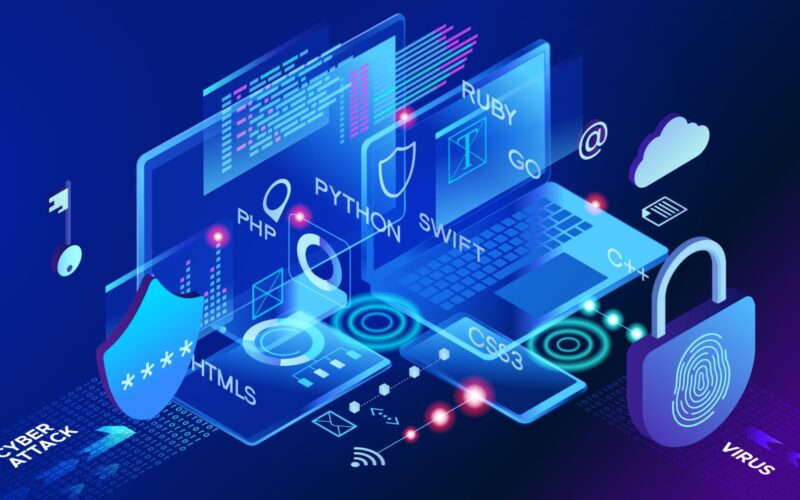Introduction
In 2025, security is a core feature of every successful digital product. Yet, studies show that nearly 74% of companies admit insecure code led to at least one security breach in the past year (ITPro, 2025).
Another report from IBM found that the average cost of a data breach has reached $4.44 million, with application vulnerabilities among the leading causes.
The reason? Many organizations still treat security as an afterthought. It is something to be added after development, not during. This reactive approach leaves critical gaps that attackers exploit long before testing or deployment.
In this guide, we’ll break down the key principles and best practices of secure application development, explore the most common risks, and show how integrating security can dramatically reduce exposure, cost, and downtime.
Key Takeaways
- Integrating security at every stage of the Software Development Lifecycle (SDLC) helps prevent vulnerabilities before they reach production.
- Threats like injection attacks, broken authentication, and insecure APIs can be mitigated through secure coding and continuous testing.
- Automation and DevSecOps practices accelerate development while maintaining high security standards through continuous scanning and monitoring.
- Building a security-first mindset across design, engineering, and QA teams ensures long-term product and brand resilience.
What is Secure Application Development?
Secure application development is the process of designing, building, and maintaining software with security integrated at every stage of the development lifecycle. Instead of adding protection measures after coding, embed them from the start, i.e, during design, coding, testing, deployment, and maintenance.
The goal is to prevent vulnerabilities, such as data breaches, injection attacks, and unauthorized access, before they occur. It combines secure coding practices, threat modeling, code review, automated security testing, and continuous monitoring to ensure applications remain resilient against evolving threats.
Even with clear frameworks in place, many organizations still face recurring security threats. Knowing what these vulnerabilities look like and how they emerge is the first step toward preventing them.
Common Application Development Risks & Vulnerabilities
Security flaws often emerge when applications are built without consistent security checks during development.
Below are the most frequent risks every business should be aware of:
1. Injection Attacks
Attackers exploit input fields to insert malicious code (e.g., SQL, NoSQL, or command injection).
Impact: Data loss, unauthorized access, and full system compromise.
2. Broken Authentication
Weak or poorly implemented authentication allows attackers to assume user identities.
Impact: Credential theft, unauthorized transactions, and account takeovers.
3. Insecure APIs
Unvalidated or unprotected APIs expose sensitive endpoints.
Impact: Data leakage, unauthorized data manipulation, and backend system access.
4. Cross-Site Scripting (XSS)
Malicious scripts are injected into web pages viewed by other users.
Impact: Session hijacking, data theft, or redirection to fraudulent sites.
5. Misconfigured Security Settings
Unsecured cloud storage, open ports, or outdated server configurations create exploitable gaps.
Impact: Unauthorized access, system exposure, and compliance violations.
6. Outdated Dependencies and Libraries
Using outdated frameworks or third-party components introduces known vulnerabilities.
Impact: Easier exploitation by attackers using public vulnerability databases.
7. Insufficient Data Encryption
Unencrypted data in storage or transit can be intercepted or modified.
Impact: Data breaches, financial loss, and violation of privacy regulations.
8. Lack of Access Control
Improper role management allows users to perform actions beyond their permissions.
Impact: Data tampering, unauthorized data exposure, and privilege escalation.
Each of these vulnerabilities is well-documented in the OWASP Top 10 and can be prevented through secure coding standards, continuous testing, and strict configuration management from the earliest stages of development.
Understanding the risks gives context, but mitigating them requires disciplined, repeatable practices. Let’s look at the core principles that teams should follow to build secure, resilient applications.
Must Read: Data Driven Decisions: How Patient Charting Software Enhances Clinical Care
10 Best Practices for Secure Application Development
Embedding security throughout the software development lifecycle ensures applications are resilient from the start.
Below are the most critical best practices every development team should follow:
1. Follow Secure Coding Standards
Adopt frameworks such as the OWASP Secure Coding Guidelines and CERT standards to minimize common coding errors. Document and enforce secure patterns for input validation, error handling, and data storage across all projects.
2. Implement Input Validation and Output Encoding
Validate all user inputs on both client and server sides to prevent injection and cross-site scripting attacks. Escape or sanitize all outputs before displaying them to users to block malicious scripts.
3. Use Strong Authentication and Access Control
Implement multi-factor authentication (MFA) and enforce least-privilege principles for user roles. Ensure session tokens and cookies are protected with secure attributes like HttpOnly and Secure.
4. Secure API Design and Management
Use authentication mechanisms such as OAuth 2.0 and API gateways to protect endpoints. Encrypt payloads and apply rate-limiting to prevent brute-force or denial-of-service attacks.
5. Encrypt Data at Rest and in Transit
Use strong encryption algorithms (AES-256 for data storage, TLS 1.2+ for transmission). Never hardcode credentials or keys in code; store them securely using vaults or secret managers.
6. Keep Dependencies and Libraries Updated
Regularly scan third-party packages with tools like Dependabot, Snyk, or OWASP Dependency-Check. Remove unused dependencies and immediately patch vulnerable components.
7. Automate Security Testing
Integrate Static Application Security Testing (SAST) and Dynamic Application Security Testing (DAST) into CI/CD pipelines. Automated scans ensure vulnerabilities are caught early without slowing development.
8. Maintain Secure Configuration Management
Harden servers, disable unnecessary services, and use Infrastructure as Code (IaC) tools with embedded security policies. Validate configurations continuously using compliance-as-code frameworks.
9. Establish Continuous Monitoring and Logging
Track authentication attempts, failed logins, and privilege escalations using centralized logging systems. Use tools such as SIEMs or cloud-native monitoring to detect anomalies in real time.
10. Build a Security-First Culture
Train developers to recognize and prevent vulnerabilities during code reviews. Encourage regular security assessments, red team exercises, and knowledge sharing across teams.
Secure application development is an ongoing discipline. Teams that integrate these practices into everyday workflows build software that’s fast, scalable, and trusted.
Need help implementing these best practices? Partner with Codewave’s security and DevSecOps experts to build applications that are secure by design.
Following best practices sets the right foundation, but to make security truly sustainable, it must be integrated into every development phase. This is where the concept of a secure SDLC comes in.
Must Read: Codewave – design thinking & digital transformation blog
Secure Application Development Lifecycle (SDLC) – Security by Design
Security should be embedded into every stage of the Software Development Lifecycle (SDLC). This proactive approach, often called “shift-left security,” ensures vulnerabilities are identified and mitigated early, reducing the cost and complexity of fixes later.
1. Planning and Requirement Analysis
- Identify security goals, data sensitivity, and compliance requirements (e.g., GDPR, HIPAA, PCI DSS).
- Define acceptance criteria that include security outcomes, such as encryption, access control, and audit logging.
- Conduct a high-level risk assessment before technical design begins.
2. Design and Architecture
- Incorporate threat modeling (STRIDE or PASTA) to identify potential attack vectors.
- Choose secure design patterns and frameworks, and follow the least privilege and defense-in-depth principles.
- Validate the architecture against standards such as the OWASP ASVS or the NIST SSDF.
3. Development (Build Phase)
- Enforce secure coding standards and peer code reviews.
- Integrate Static Application Security Testing (SAST) and Software Composition Analysis (SCA) into CI pipelines.
- Use secrets management tools to avoid hardcoded credentials.
4. Testing and Verification
- Run Dynamic Application Security Testing (DAST) and Interactive Application Security Testing (IAST) on staging environments.
- Conduct penetration testing for high-risk features before production.
- Track and remediate vulnerabilities based on severity and SLA.
5. Deployment and Release
- Automate deployments with DevSecOps pipelines and built-in security gates.
- Use Infrastructure as Code (IaC) templates validated against security baselines.
- Verify digital signatures of all artifacts before deployment.
6. Monitoring and Maintenance
- Continuously monitor logs, access patterns, and API calls through SIEM or cloud-native monitoring tools.
- Patch dependencies and rotate secrets regularly.
- Perform regular post-deployment security reviews and incident simulations.
Embedding security into each SDLC phase transforms development from reactive to preventive. This ensures that every product built is resilient, compliant, and trusted from day one.
A secure SDLC establishes structure, but execution depends on how well teams adopt automation, governance, and continuous monitoring. Let’s see how Codewave brings this vision to life across industries.
Must Read: Codewave Insights Retail App Development 2025: Trends, Costs, and Features That Matter Most
How Codewave Ensures Secure Application Development?
At Codewave, security is an architectural principle woven into every stage of the product lifecycle.
The engineering teams combine design thinking, DevSecOps automation, and continuous compliance to help enterprises build software that’s both innovative and inherently secure.
1. Security-by-Design Philosophy
Every project starts with security risk mapping and threat modeling. Codewave integrates OWASP ASVS and NIST SSDF principles during the design phase to ensure each feature aligns with compliance and privacy expectations.
2. Secure Development & CI/CD Automation
Through integrated pipelines that include SAST, DAST, and dependency scanning, vulnerabilities are detected and resolved before code ever reaches production. This “shift-left” approach allows us to maintain speed without compromising security.
3. Cloud & Infrastructure Hardening
Codewave’s DevOps teams apply Infrastructure-as-Code (IaC) and cloud-native security policies to enforce encryption, access control, and network isolation across all environments. This ensures zero-trust implementation from the start.
4. Continuous Monitoring & Governance
Post-deployment, we enable real-time monitoring via a SIEM and automated alerts for anomalous activity. Regular penetration testing and audit reviews ensure applications remain resilient against evolving threats.
5. Proven Outcomes Across Industries
From FinTech to Healthcare and Education, Codewave has helped clients build secure, compliant platforms that scale confidently. Measurable outcomes, such as reduced incident risk, faster compliance audits, and greater customer trust, drive each engagement.
Conclusion
Security must be an integral part of every design decision, line of code, and deployment process. The rise in application-layer attacks has shown that even the most innovative products can lose user trust overnight if built without a strong security foundation.
By following secure application development best practices, businesses can minimize vulnerabilities and strengthen resilience against evolving threats.
Beyond protecting data, secure development safeguards reputation, ensures compliance, and builds long-term customer confidence.
Looking to build a secure, future-ready application? Explore Codewave’s portfolio to see how we design, build, and scale digital products that are inherently secure.
FAQs
1. What is the main goal of secure application development?
The goal is to identify and eliminate vulnerabilities during development and not after deployment. It ensures that every layer of an application is designed to prevent unauthorized access and security breaches.
2. How is secure application development different from application security testing?
Secure development integrates security throughout the Software Development Lifecycle (SDLC). Application security testing is a validation step to detect vulnerabilities that may have slipped through.
3. What tools help automate secure development practices?
Common tools include SonarQube, Checkmarx, and Veracode for static code analysis (SAST), Burp Suite and OWASP ZAP for dynamic testing (DAST), and Snyk or Dependency-Check for third-party library scanning.
4. How often should applications be tested for security vulnerabilities?
Security testing should occur during every major release and after any significant code or infrastructure change. In agile or DevOps environments, automated security scans are ideally run on every commit or build.
Codewave is a UX first design thinking & digital transformation services company, designing & engineering innovative mobile apps, cloud, & edge solutions.







